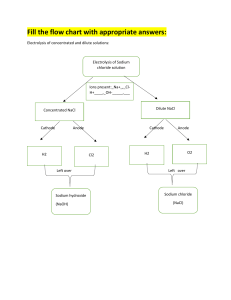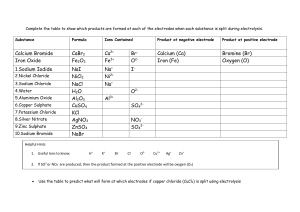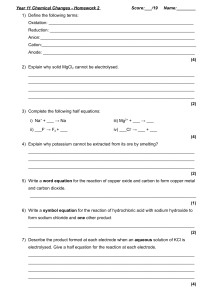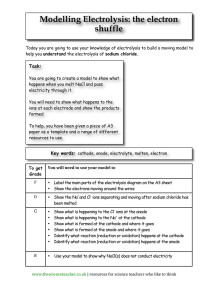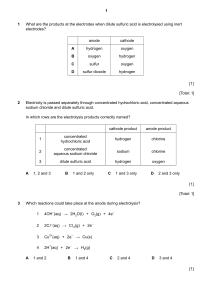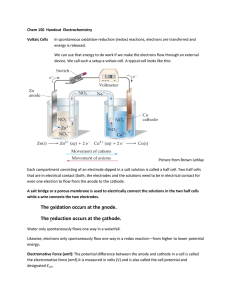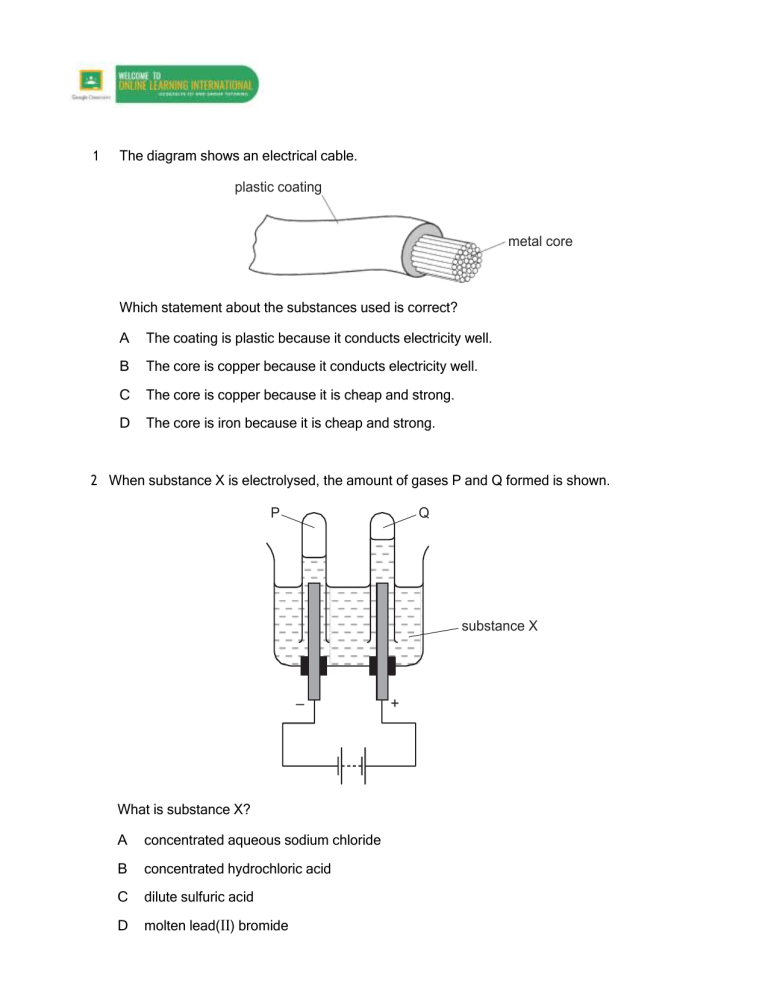
1 The diagram shows an electrical cable. plastic coating metal core Which statement about the substances used is correct? A The coating is plastic because it conducts electricity well. B The core is copper because it conducts electricity well. C The core is copper because it is cheap and strong. D The core is iron because it is cheap and strong. 2 When substance X is electrolysed, the amount of gases P and Q formed is shown. P Q substance X – What is substance X? A concentrated aqueous sodium chloride B concentrated hydrochloric acid C dilute sulfuric acid D molten lead(II) bromide + 3 What are the products at the electrodes when dilute sulfuric acid is electrolysed using inert electrodes? 4 Electricity is passed separately through concentrated hydrochloric acid, concentrated aqueous sodium chloride and dilute sulfuric acid. In which rows are the electrolysis products correctly named? A 5 cathode product anode product 1 concentrated hydrochloric acid hydrogen chlorine 2 concentrated aqueous sodium chloride sodium chlorine 3 dilute sulfuric acid hydrogen oxygen 1, 2 and 3 B 1 and 2 only C 1 and 3 only D 2 and 3 only Which row describes the electrolysis of molten potassium bromide? 6 The diagram shows a section of an overhead power cable. steel ceramic aluminium Which statement explains why a particular substance is used? A Aluminium has a low density and is a good conductor of electricity. B Ceramic is a good conductor of electricity. C Steel can rust in damp air. D Steel is more dense than aluminium. 7 The diagram shows the electrolysis of concentrated hydrochloric acid and concentrated aqueous sodium chloride using carbon electrodes. electrode 1 + – electrode 2 concentrated hydrochloric acid electrode 3 + – electrode 4 concentrated aqueous sodium chloride At which electrode(s) is hydrogen produced? 8 A electrode 1 only B electrodes 1 and 3 C electrode 2 only D electrodes 2 and 4 What are the electrode products when molten silver iodide is electrolysed between inert electrodes? 9 Copper and hydrogen can each be formed by electrolysis. At which electrodes are these elements formed? 10 The diagram shows a failed attempt to copper-plate a pan. 3V + – copper cathode pan copper sulfate solution Which action will plate the pan with copper? A cooling the copper sulfate solution in an ice bath B heating the copper sulfate solution to boiling point C increasing the voltage from 3 V to 6 V D making the pan the cathode and the copper the anode 11 The diagram shows the electroplating of a steel object. + – steel object copper copper(II) sulfate solution A student made the following statements. 1 The object turns a reddish-brown colour. 2 The copper sulfate solution changes to a paler blue colour. 3 The copper electrode becomes smaller. Which statements are correct? A 1, 2 and 3 B 1 and 2 only C 1 and 3 only D 2 and 3 only 12 An object is electroplated with silver using an aqueous silver salt as the electrolyte. Which set of conditions is used? 13 The diagram shows an electrolysis experiment. electrode Q electrode P X During the electrolysis, sodium was formed at electrode P and chlorine at electrode Q. Which row correctly identifies P, Q and X? P Q X A anode cathode concentrated solution of sodium chloride in water B anode cathode molten sodium chloride C cathode anode concentrated solution of sodium chloride in water D cathode anode molten sodium chloride 14 The diagram shows apparatus for plating a spoon with silver. spoon metal electrode electrolyte Which statement is not correct? A Silver would stick to the spoon because it is a very reactive metal. B The electrolyte would be a silver salt dissolved in water. C The metal electrode would be made from silver. D The spoon would be connected to the negative terminal of the power supply. 15 Which metal could not be used for electroplating by using an aqueous solution? A chromium B copper C silver D sodium 16 Which products are formed at the electrodes when a concentrated solution of sodium chloride is electrolysed? 17 A student wishes to electroplate an object with copper. Which row is correct? 18 In the electrolysis shown, chlorine is produced at W and sodium at X. W + – X Y Which labels are correct? 19 Which substance will not conduct electricity? A aluminium B copper C plastic D steel 20 Which products are formed at the anode and cathode when electricity is passed through molten lead(II) bromide? anode (+) cathode (–) A bromide ions lead ions B bromine molecules lead atoms C lead atoms bromine molecules D lead ions bromide ions 21 Electrical cables are made from either ……1……, because it is a very good conductor of electricity, or from……2……, because it has a low density. Overhead cables have a ……3…… core in order to give the cable strength. Which words correctly complete gaps 1, 2 and 3? 22 What will be produced at the anode and at the cathode, if molten potassium chloride is electrolysed? 23 The diagram shows the circuit for electrolysing lead(II) bromide and sodium chloride to liberate the metal. A container for lead(II) bromide container for sodium chloride In what form are these salts electrolysed for liberating the metal? 24 The diagram shows the electrolysis of concentrated aqueous sodium chloride. anode – + cathode carbon rods concentrated aqueous sodium chloride and litmus What is the colour of the litmus at each electrode after five minutes? 25 Two electrolysis experiments were carried out as shown in the diagram below. The graphite electrodes are labelled 1-4. + 1 – 2 + 3 molten sodium chloride – 4 concentrated aqueous sodium chloride Which row describes the products at the electrodes in these experiments? 26 One molten compound and two aqueous solutions were electrolysed. The table gives the compounds electrolysed and the electrodes used. substance electrolysed electrodes 1 concentrated hydrochloric acid carbon 2 concentrated sodium chloride platinum 3 molten lead bromide platinum In which experiments is a gas evolved at the cathode? A 1, 2 and 3 B 1 and 2 only C 1 only D 3 only 27 The diagram shows an incomplete circuit. lamp glass tube Which substance causes the lamp to light when added to the glass tube? A aqueous sodium chloride B aqueous sugar C solid sodium chloride D solid sugar 28 The diagram shows an electrical cable. plastic coating metal core Which statement about the substances used is correct? A The coating is plastic because it conducts electricity well. B The core is copper because it conducts electricity well. C The core is copper because it is cheap and strong. D The core is iron because it is cheap and strong. 29 The diagram shows an electrolysis circuit. At which electrode is hydrogen formed? + A – + B aqueous sodium chloride C – D molten sodium chloride 30 Some white anhydrous copper(II) sulfate powder is put into a beaker of water and stirred. What would show that the process was exothermic? A A blue solution is formed. B The beaker feels cooler. C The beaker feels warmer. D The powder dissolves in the water. 31 Concentrated aqueous sodium chloride, concentrated hydrochloric acid and molten lead bromide were separately electrolysed in experiments 1, 2 and 3. experiment 1 concentrated aqueous sodium chloride experiment 2 platinum electrodes concentrated hydrochloric acid platinum electrodes experiment 3 d.c. power supply lamp LEAD BROMIDE TOXIC heat Which statement about the electrode products is correct? A Gases were given off at the anode in experiments 2 and 3 only. B Gases were given off at the cathode in experiments 1 and 2 only. C Metals were formed at the anode in experiments 1 and 3 only. D Metals were formed at the cathode in experiments 1 and 3 only. 32 The diagram shows the electrolysis of concentrated aqueous sodium chloride. positive electrode – + carbon rods negative electrode concentrated aqueous sodium chloride What is produced at each of the electrodes? 33 The diagram shows an electrolysis experiment using metals X and Y as electrodes. + – aqueous solution X Y One of the metals becomes coated with copper. Which metal becomes coated and which aqueous solution is used? metal aqueous solution A X Cr l 3 B X Cu l 2 C Y Cr l 3 D Y Cu l 2 34 In separate experiments, electricity was passed through concentrated aqueous sodium chloride and molten lead bromide. What would happen in both experiments? A A halogen would be formed at the anode. B A metal would be formed at the cathode. C Hydrogen would be formed at the anode. D Hydrogen would be formed at the cathode. 35 Winston Churchill, a British Prime Minister, had his false teeth electroplated with gold. The teeth were coated with a thin layer of carbon and were then placed in the apparatus shown. X false teeth Y switch gold aqueous solution of a gold salt Which row is correct? 36 The diagram shows that two gases are formed when concentrated hydrochloric acid is electrolysed using inert electrodes. +ve –ve concentrated hydrochloric acid Which row correctly describes the colours of the gases at the electrodes? 37 The diagram shows a section of an overhead power cable. steel glazed porcelain aluminium Which statement explains why a particular substance is used? A Aluminium has a low density and is a good conductor of electricity. B Porcelain is a good conductor of electricity. C Steel can rust in damp air. D Steel is more dense than aluminium. 38 Metals could be extracted from their molten chlorides using electrolysis. Which substances are formed at each electrode? 39 Concentrated aqueous potassium bromide solution is electrolysed using inert electrodes. + + The ions present in the solution are K , Br , H and OH . To which electrodes are the ions attracted during this electrolysis? attracted to anode Br and K B Br and OH C H and K D 40 + A + + + H and OH attracted to cathode + H and OH + H and K + Br and OH Br and K + Electricity from a power station passes through overhead cables to a substation and then to a school where it is used to electrolyse concentrated hydrochloric acid using inert electrodes. Which substances are used for the overhead cables and for the electrodes? 41 Which statement about the electrolysis of molten lead(II) bromide is correct? A A colourless gas is seen at the cathode. B A grey metal is seen at the anode. C A red / brown gas is seen at the anode. D A red / brown metal is seen at the cathode. 42 Electricity is passed through concentrated aqueous sodium chloride, as shown. positive electrode negative electrode – + carbon rods concentrated aqueous sodium chloride What is the test for the gas formed at the positive electrode? A bleaches damp litmus paper B ‘pops’ with a lighted splint C relights a glowing splint D turns damp red litmus paper blue 43 The diagram shows apparatus used in an attempt to electroplate a metal ring with copper. + – bulb metal ring copper electrode aqueous copper(II) sulfate (electrolyte) The experiment did not work. What change is needed in the experiment to make it work? A Add solid copper(II) sulfate to the electrolyte. B Increase the temperature of the electrolyte. C Replace the copper electrode by a carbon electrode. D Reverse the connections to the battery. 44 When concentrated sodium chloride solution is electrolysed, elements X and Y are formed. X Y concentrated sodium chloride solution – + What are X and Y? 45 Substance X was electrolysed in an electrolytic cell. A coloured gas was formed at the anode and a metal was formed at the cathode. power supply anode cathode substance X What is substance X? A aqueous sodium chloride B molten lead bromide C molten zinc oxide D solid sodium chloride 46 The diagram shows apparatus for plating a spoon with silver. spoon metal electrode electrolyte Which statement is not correct? A Silver would stick to the spoon because it is a very reactive metal. B The electrolyte would be a silver salt dissolved in water. C The metal electrode would be made from silver. D The spoon would be connected to the negative of the power supply. 47 Aqueous copper(II) sulfate solution is electrolysed using inert electrodes. Copper(II) ions (Cu2+), hydrogen ions (H+), hydroxide ions (OH ) and sulfate ions ( SO 42 ) are present in the solution. To which electrodes are the ions attracted during this electrolysis? attracted to anode 2+ + A Cu and H B Cu and SO4 C H and OH D 2+ OH and SO4 2 2 + H and OH 2+ + OH and SO4 attracted to cathode Cu and SO4 2 2+ Cu and H + 2 48 Three electrolysis cells are set up. Each cell has inert electrodes. The electrolytes are listed below. cell 1 aqueous sodium chloride cell 2 concentrated hydrochloric acid cell 3 molten lead(II) bromide In which cells is a gas formed at both electrodes? A 1 and 2 B 1 and 3 C 2 only D 3 only 49 The diagram shows how aluminium is manufactured by electrolysis. anode (+ve) aluminium oxide dissolved in cryolite What are the anode and cathode made of? cathode (–ve) molten aluminium 50 The diagram shows the electrolysis of concentrated aqueous sodium chloride. positive electrode negative electrode – + carbon rods concentrated aqueous sodium chloride and Universal Indicator What is the colour of the Universal Indicator at each electrode after five minutes? 51 The diagram shows an electrical cable. plastic coating metal core Which statement about the substances used is correct? A The coating is plastic because it conducts electricity well. B The core is copper because it conducts electricity well. C The core is copper because it is cheap and strong. D The core is iron because it is cheap and strong. 52 Aluminium is extracted from its oxide by electrolysis. The oxide is dissolved in ……1…… cryolite and aluminium is deposited at the ……2…… Which words correctly complete gaps 1 and 2? 13 Molten lead(II) bromide is electrolysed as shown. + – A molten lead(II) bromide Which ions are discharged at each electrode? positive electrode negative electrode A Pb+ Br2 B Pb2+ Br C Br2 Pb+ D Br Pb2+ 14 Which of these elements could be formed at the anode when a molten salt is electrolysed? A copper B iodine C lithium D strontium
